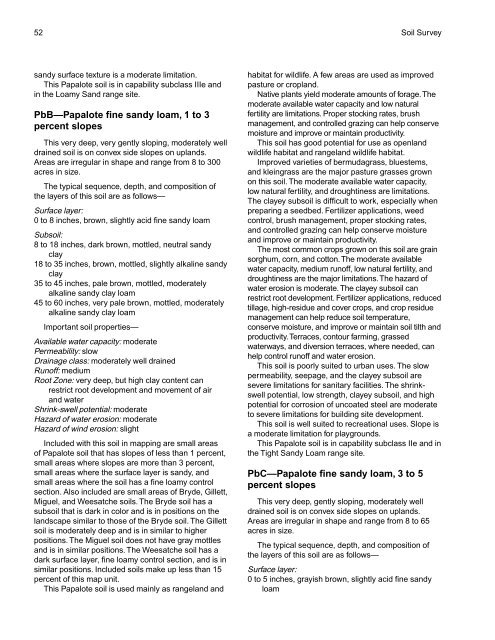Soil Survey of Karnes County, Texas - Soil Data Mart - US ...
Soil Survey of Karnes County, Texas - Soil Data Mart - US ...
Soil Survey of Karnes County, Texas - Soil Data Mart - US ...
You also want an ePaper? Increase the reach of your titles
YUMPU automatically turns print PDFs into web optimized ePapers that Google loves.
52 <strong>Soil</strong> <strong>Survey</strong><br />
sandy surface texture is a moderate limitation.<br />
This Papalote soil is in capability subclass IIIe and<br />
in the Loamy Sand range site.<br />
PbB—Papalote fine sandy loam, 1 to 3<br />
percent slopes<br />
This very deep, very gently sloping, moderately well<br />
drained soil is on convex side slopes on uplands.<br />
Areas are irregular in shape and range from 8 to 300<br />
acres in size.<br />
The typical sequence, depth, and composition <strong>of</strong><br />
the layers <strong>of</strong> this soil are as follows—<br />
Surface layer:<br />
0 to 8 inches, brown, slightly acid fine sandy loam<br />
Subsoil:<br />
8 to 18 inches, dark brown, mottled, neutral sandy<br />
clay<br />
18 to 35 inches, brown, mottled, slightly alkaline sandy<br />
clay<br />
35 to 45 inches, pale brown, mottled, moderately<br />
alkaline sandy clay loam<br />
45 to 60 inches, very pale brown, mottled, moderately<br />
alkaline sandy clay loam<br />
Important soil properties—<br />
Available water capacity: moderate<br />
Permeability: slow<br />
Drainage class: moderately well drained<br />
Run<strong>of</strong>f: medium<br />
Root Zone: very deep, but high clay content can<br />
restrict root development and movement <strong>of</strong> air<br />
and water<br />
Shrink-swell potential: moderate<br />
Hazard <strong>of</strong> water erosion: moderate<br />
Hazard <strong>of</strong> wind erosion: slight<br />
Included with this soil in mapping are small areas<br />
<strong>of</strong> Papalote soil that has slopes <strong>of</strong> less than 1 percent,<br />
small areas where slopes are more than 3 percent,<br />
small areas where the surface layer is sandy, and<br />
small areas where the soil has a fine loamy control<br />
section. Also included are small areas <strong>of</strong> Bryde, Gillett,<br />
Miguel, and Weesatche soils. The Bryde soil has a<br />
subsoil that is dark in color and is in positions on the<br />
landscape similar to those <strong>of</strong> the Bryde soil. The Gillett<br />
soil is moderately deep and is in similar to higher<br />
positions. The Miguel soil does not have gray mottles<br />
and is in similar positions. The Weesatche soil has a<br />
dark surface layer, fine loamy control section, and is in<br />
similar positions. Included soils make up less than 15<br />
percent <strong>of</strong> this map unit.<br />
This Papalote soil is used mainly as rangeland and<br />
habitat for wildlife. A few areas are used as improved<br />
pasture or cropland.<br />
Native plants yield moderate amounts <strong>of</strong> forage. The<br />
moderate available water capacity and low natural<br />
fertility are limitations. Proper stocking rates, brush<br />
management, and controlled grazing can help conserve<br />
moisture and improve or maintain productivity.<br />
This soil has good potential for use as openland<br />
wildlife habitat and rangeland wildlife habitat.<br />
Improved varieties <strong>of</strong> bermudagrass, bluestems,<br />
and kleingrass are the major pasture grasses grown<br />
on this soil. The moderate available water capacity,<br />
low natural fertility, and droughtiness are limitations.<br />
The clayey subsoil is difficult to work, especially when<br />
preparing a seedbed. Fertilizer applications, weed<br />
control, brush management, proper stocking rates,<br />
and controlled grazing can help conserve moisture<br />
and improve or maintain productivity.<br />
The most common crops grown on this soil are grain<br />
sorghum, corn, and cotton. The moderate available<br />
water capacity, medium run<strong>of</strong>f, low natural fertility, and<br />
droughtiness are the major limitations. The hazard <strong>of</strong><br />
water erosion is moderate. The clayey subsoil can<br />
restrict root development. Fertilizer applications, reduced<br />
tillage, high-residue and cover crops, and crop residue<br />
management can help reduce soil temperature,<br />
conserve moisture, and improve or maintain soil tilth and<br />
productivity. Terraces, contour farming, grassed<br />
waterways, and diversion terraces, where needed, can<br />
help control run<strong>of</strong>f and water erosion.<br />
This soil is poorly suited to urban uses. The slow<br />
permeability, seepage, and the clayey subsoil are<br />
severe limitations for sanitary facilities. The shrinkswell<br />
potential, low strength, clayey subsoil, and high<br />
potential for corrosion <strong>of</strong> uncoated steel are moderate<br />
to severe limitations for building site development.<br />
This soil is well suited to recreational uses. Slope is<br />
a moderate limitation for playgrounds.<br />
This Papalote soil is in capability subclass IIe and in<br />
the Tight Sandy Loam range site.<br />
PbC—Papalote fine sandy loam, 3 to 5<br />
percent slopes<br />
This very deep, gently sloping, moderately well<br />
drained soil is on convex side slopes on uplands.<br />
Areas are irregular in shape and range from 8 to 65<br />
acres in size.<br />
The typical sequence, depth, and composition <strong>of</strong><br />
the layers <strong>of</strong> this soil are as follows—<br />
Surface layer:<br />
0 to 5 inches, grayish brown, slightly acid fine sandy<br />
loam
















